new posts in all blogs
Viewing: Blog Posts Tagged with: Stories for All, Most Recent at Top [Help]
Results 1 - 6 of 6
How to use this Page
You are viewing the most recent posts tagged with the words: Stories for All in the JacketFlap blog reader. What is a tag? Think of a tag as a keyword or category label. Tags can both help you find posts on JacketFlap.com as well as provide an easy way for you to "remember" and classify posts for later recall. Try adding a tag yourself by clicking "Add a tag" below a post's header. Scroll down through the list of Recent Posts in the left column and click on a post title that sounds interesting. You can view all posts from a specific blog by clicking the Blog name in the right column, or you can click a 'More Posts from this Blog' link in any individual post.

By: Marissa Wasseluk,
on 9/19/2016
Blog:
First Book
(
Login to Add to MyJacketFlap)
JacketFlap tags:
community,
Diversity,
Books & Reading,
Authors & Illustrators,
culture,
Guatemala,
America,
English,
immigrants,
Korea,
Anne Sibley O'Brien,
Somalia,
TESOL,
Stories for All,
Expert Voices,
I'm New Here,
welcoming week,
Add a tag

Welcoming Week is a special time of year. Communities across the country will come together to celebrate and raise awareness of immigrants, refugees and new Americans of all kinds. Whether it’s an event at your local art gallery or showing support on social media, the goal is to let anyone new to America know just how much they are valued and welcomed during what is likely a big transition.
And the biggest transitions are happening for the littlest people.
A new country, a new home, maybe even a new language — that would be enough for any kid — but a new school, too? That subject is exactly what author Anne Sibley O’Brien addresses in her book I’m New Here, new to the First Book Marketplace.
Marissa Wasseluk and Roxana Barillas of the First Book team had the pleasure of speaking with Anne about I’m New Here, the experiences of kids new to America, and what kids can do to help create a welcoming atmosphere.
Marissa: So, and I am sure you get this question all the time, but I’m curious — what inspired or motivated you to create I’m New Here?
It’s funny, it’s such a, “where would you start?” kind of question, but I don’t remember if anyone has ever asked me that point blank because I don’t recall ever putting together this answer before. Over the years of working in schools — especially working with Margy Burns Knight with our nonfiction books: Talking Walls; Who Belongs Here and other multi-racial, multicultural, global nonfiction books — I had a lot of encounters, a lot of discussions, a lot of experiences with immigrant students and I was very aware of the kinds of cross-cultural challenges that children and teachers can experience. For instance, Cambodian children show respect by keeping their eyes down and not looking in the eyes of an adult, especially a teacher. In Cambodian culture adults don’t ever touch children’s heads. So you can immediately imagine how those kinds of things would be quite challenging when a Cambodian child comes into a U.S. classroom and suddenly two of those cultural markers are not only gone, but the opposite is what they need to learn.
Somebody might put their hand on your head — it being out of concern and wanting to make a connection — or they might say “I need you to look at me now” and not recognize that that’s cultural inappropriate for a Cambodian child. So growing that kind of awareness of the challenges that immigrant children face — that was the original impetus for the book. Just collecting some of those stories and raising awareness of how many obstacles immigrant children face. From climate to traditions in speaking and in body language, to food, to learning a new language. Not just learning a new language in terms of how you speak and read and write, but also how you interact with people, how social norms work — they just face such enormous challenges. And there were originally six characters so it was trying to cover everything.
Marissa: The characters that are in the book, they cover a child from Guatemala, a child from Korea, and a child from Somalia — did you work with these specific immigrant communities when you were creating this book?
I spoke to individual experts, such as several Somali interpreters and family liaison experts who work for the multi-lingual, multicultural office of the Portland, ME public schools. So I had that kind of expert advice to respond to what I was writing. But the original ideas mostly came from my observations, my interactions with Somali students in the classrooms that I visited. And then with Korean students I met many, many Korean students here in the US and I had my own background to draw on there.
Marissa: Can you tell me a little bit more about these classrooms that you’ve visited? We talk with a lot of educators who work with Title I schools and they often talk about how reserved the English as a second language students can be. There is a silent phase that a lot of kids go through. Have you observed that and have you shared your book with any of these first generation immigrants?
It’s certainly been shared with many. I actually just shared it with a group of students in a summer school program — about seventy students from third to fifth grade who were from East African countries and some Middle Eastern countries. Most of the group were immigrants and I read the book and then we had a discussion about being new and being welcoming. Of all the student groups that I’ve worked with, they were actually the most effusive and had the most to share in that discussion about what it feels like to be new and what you can do to welcome someone.
Marissa: What were some of the suggestions?
They had all kinds of ideas about what you could say and do to make somebody feel like they were at home. You could take them around, go through a list and say, “this is your classroom, this is your teacher, this is your playground, this is your classmate.”
Roxana: You’re taking me back – a few years back I came to the United States when I was twelve from El Salvador, speaking no English. It hits close to home in terms of the importance of the work you are doing, not just for kids who may not always feel like they belong, but also for the kids who can actually help that process be an easier one.
 That is wonderful to hear. I was just struck that they had more suggestions than any group I’d worked with, they could hardly be contained. They had so much they wanted to say and I think it’s very fresh in their minds what welcoming looks like and maybe what did or what didn’t happen for them. So the list that they wrote: welcome to my class, say hi, wave, smile, hello, say this is my classroom, these are my friends, do you want to become friends? these are my parents, this is my family, show them around, this is my chair, this is my house, this is your school, this is my teacher, can you read with me? how’s it going? I live here, where do you live? do you need help? welcome to my school.
That is wonderful to hear. I was just struck that they had more suggestions than any group I’d worked with, they could hardly be contained. They had so much they wanted to say and I think it’s very fresh in their minds what welcoming looks like and maybe what did or what didn’t happen for them. So the list that they wrote: welcome to my class, say hi, wave, smile, hello, say this is my classroom, these are my friends, do you want to become friends? these are my parents, this is my family, show them around, this is my chair, this is my house, this is your school, this is my teacher, can you read with me? how’s it going? I live here, where do you live? do you need help? welcome to my school.
It was the specificity of it that I just loved.
And they said what it felt like to be new. These kids went beyond with the details so they said: scared, nervous, confused, happy, sad, lonely, shy, surprised. Which is what I get with any group that I talk to — but then they wrote: don’t know how to write, don’t know everybody, don’t know what to do, don’t know what they’re saying, don’t know what to say, don’t think you fit in, embarrassed, don’t know how to read books, don’t know what to think, don’t know how to play games, don’t know how to respond, don’t know how to use the computer. So that is a really rich, concrete list.
Marissa: What about educators, how have educators responded to your book?
It’s been pretty phenomenal. The book is in its third printing and it’s just a year old. Actually, it went into its third print run in June. That is by far the fastest that any book of mine has taken off, so there seemed to really be a hunger. There are quite a number of books about an individual immigrant’s story, but I think what people are responding to, what they found useful, is that this book is different because it’s a concept book about the experience of being new and being welcoming, and in that way it works. A particular story can make a deep connection even if your experience is quite different, you recognize things that are similar. But to have one book that outlines what the experience is like, it is very good for discussions. I’ve done more teacher conferences and appearances, especially in the TESOL community, than I did before. Normally I do a lot of schools where I talk to students, but in the past year the majority of my appearances have been for teacher conferences.
Marissa: Have any of them come up to you and told you how it’s resonated with them? Have you met any educators who are immigrants themselves?
Yes, definitely! The TESOL community is full of people who have immigrant backgrounds. I shouldn’t say full, but there is quite a healthy percentage of the TESOL community who come from that background themselves. Partly because schools often recruit someone who’s bilingual, so you tend to get a lot of wonderful richness of people’s life experiences. They might be second generation or they might not have come as a child but they definitely make a strong connection to children who have that experience. I remember, in particular, some very moving statements that people made standing in line waiting to have a book signed. Talking about how it was “their story” or people talking about and being reminded of their own students. When I talked about the book they were in tears thinking about their own students.
Marissa: Ideally, how would you like to see your book being used in a classroom or a child’s home?
I think I see it in two ways. First, for a child who has just arrived and who is in a situation where things are strange; to be able to recognize themselves and see that their experience is reflected in something that makes them feel less lonely and that there is hope. Many, many people have gone through this experience and it can be so difficult but you can get through.
And to the children who are not recent immigrants, who have been part of a community for generations; that it would spark empathy for children, for them to imagine what it would be like if they had that experience. Starting with that universal experience of somehow being new somewhere and to recognize, “oh, I remember what that felt like” and imagine if it was not only a new school, but a new country and a new language and a new culture and new food and new religions and on and on and on. Particularly for them to imagine what they could do, concretely, to examine what the new children are doing and to see how hard they are working, the effort that they are making. And also how their classmates are responding so that the outcome is the whole group building a community together.
To learn more about I’m New Here and Anne’s perspective, watch and listen as she discusses the book and her insights into the experiences of immigrant children.
The post Welcoming Week: Q&A with Author Anne Sibley O’Brien appeared first on First Book Blog.


By: Marissa Wasseluk,
on 8/19/2016
Blog:
First Book
(
Login to Add to MyJacketFlap)
JacketFlap tags:
Books & Reading,
Authors & Illustrators,
author interview,
Jason Reynolds,
stories for all,
diverse books,
all american boys book,
author jason reynolds,
ghost book,
Add a tag
Author Jason Reynolds’ books start the conversations about the difficult issues facing kids today. His experiences, as told through the characters in his stories, are very much like those of the children we serve – which is why we feel it’s so important for them to hear Jason’s voice.
We had the opportunity to talk with Jason about his experiences, his journey to becoming an author, and how he’s seen his books affect young readers.

Q. Were you an avid reader as a child?
A. Absolutely not. I actually didn’t read much at all, though I had books all around me. Most of them were classics. Canonical literature. But to a kid growing up in the midst of the hip-hop generation, a time where most young people of color were exposed to the hardships of drugs and violence, I gravitated more toward the storytelling of rap music, than I did the dense and seemingly disconnected narrative arc of books (during that time).
Q. What stories or poetry did you connect with as a young person? Did you have trouble connecting with stories as a child?
A. I had a really hard time connecting with stories as a child, especially within the confines of a book. But I was introduced to poetry by reading the lyrics of Queen Latifah, Tupac, Slick Rick, and lots of other rappers. From there, I started to make connections between their lyrics and the poetry of Langston Hughes and Maya Angelou. But eventually I began reading more traditional narratives, the first being Black Boy, by Richard Wright. It changed my life.
Q. Are there books you’ve read today that you wish you’d been exposed to as a child or young adult?
A. All of Walter Dean Myers’s work. Also, I wish there would’ve been as much focus on graphic novels back then, as there is now. That would’ve been extremely valuable to me.
Q. We first met you as a writer through your poetry in My Name is Jason. Why did you make the transition into writing novels? And how is your process for writing poetry different than writing novels?
A. I never wanted to write novels, so you can blame Christopher Myers for that. He’s the one who challenged me to give it a shot. My plan was to be only a poet. But there was something in Walter Dean Myers’s stories — a permission to be myself on the page I hadn’t felt before. So I let myself be myself, let my language live freely on the page without the pretense and pressure of the academy or some phantom scholarship. And turns out, it worked! Now, the poetry was a big help mainly because as a poet I valued the importance of beginning and ending, which has lent itself to my work tremendously.
Q. You toured extensively with Brendan Kiely for All American Boys. Can you recount a few of the most powerful moments you had with students and/or with adults while on tour?
There were so many. One thing that was interesting was, everywhere we went we would ask the students the same two questions: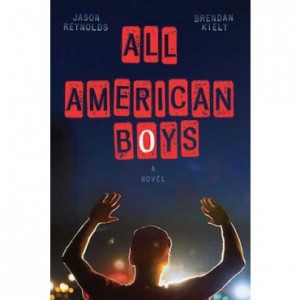
1.) How many of you know about police brutality? They’d all raise their hands. And,
2.) How many of you have spoken to your friends about it? Ninety percent of the hands went down.
We realized that kids knew about it but weren’t discussing it, but we also deduced that it wasn’t because they didn’t want to talk about it, but instead was because they didn’t have the framework or the safe space to do so. By the end of our presentation, everyone always had questions and comments, ready for the hard conversation. Some other interesting moments . . . We met a man in Cincinnati, a white man raising two black boys. He came over to us and explained that All American Boys had helped him understand what his sons might be facing outside of his home, and that he needed to be as open as possible and as emotionally and mentally equipped so that he could serve as not only their father, but as their ally. He even said reading the book helped him feel more whole. I also had a student come to me, a young black girl in Philly, who wanted to know if I ever wished I could change the color of my skin, just because she was afraid of the fear other people have of it. She was in the seventh grade, and in that moment I got to pour into her. Tell her that she was perfect the way she was. I have tons of these stories. Mexican kids in Texas who wondered what their role is. Wealthy white boys in Baltimore forming cultural sensitivity groups in their schools. Even recently watching a group of students perform the theatrical version of All American Boys in Brooklyn. Young people are ready to talk. And they’re ready to act. We (adults) just have to arm them.
 Q. Do you see your teenage self in any of your novels? If so, which one(s) and in what ways?
Q. Do you see your teenage self in any of your novels? If so, which one(s) and in what ways?
A. I’m in all of them. Each and every one of them. I like to pull from actual stories from my teenage years, like Ali and the MoMo party in, When I Was The Greatest, or Matt Miller and his mother’s cancer in, The Boy in The Black Suit. I’m always the protagonist, at least parts of me. Writing is cathartic for me, and a way to process parts of my life that I’ve either worked hard to hold on to, or have desperately tried to forget.
Q. How important was it to have a co-author for Quinn’s voice in All American Boys?
A. It was paramount. The truth is, I might’ve been able to write a decent book, based around Rashad’s narrative, but what Brendan brings to the story with Quinn is, to me, the most important part of the story. It’s the part we don’t hear about, and the part most necessary to sit with and dissect when it comes to making change. It’s something I’m not sure I could’ve written with the same authenticity as Brendan, and I couldn’t have asked for a better partner on that project.
Q. Why do you feel it’s important for kids of varied backgrounds to read the stories you write?
A. You know, I think about this often, and I think ultimately what I hope is that they read my books and feel cared for. Feel less alone. There’s an impenetrable power to simple acknowledgement.
Q.Why is it important for kids, especially kids from low-income communities, to have access to brand-new books?
A. It’s important for kids from low-income communities to have brand-new anything. But if it could be a book, let alone a book that speaks directly to their experiences, then it’s a double-win.
Watch the video below for more insights from Jason:
Thanks to the support of Jason Reynolds’ publisher, Simon & Schuster, 20,000 of Reynolds’ young adult and middle grade titles will be distributed to children in need through First Book.
The post Q&A with Author Jason Reynolds appeared first on First Book Blog.


By: Samantha McGinnis,
on 5/12/2015
Blog:
First Book
(
Login to Add to MyJacketFlap)
JacketFlap tags:
Book lists,
Books & Reading,
And Tango Makes Three,
Knock Knock,
The Stories for All Project,
Stories For All Project,
Stories for All,
Nino Wrestles the World,
Tiger in My Soup,
Emmanuel's Dream,
Boats for Papa,
Add a tag
Today’s blog post is part of our Stories For All Project series, focused on sharing the latest announcements and impact stories about our effort to put diverse, inclusive books into the hands of kids.
Last week, we announced our latest action in the Stories for All Project – we selected six outstanding titles that showcase characters and storylines often underrepresented in children’s literature and are making 10,000 copies of each title available in affordable trade paperback format for the first time ever.
The first three titles are available now on the First Book Marketplace and in Target stores nationwide.
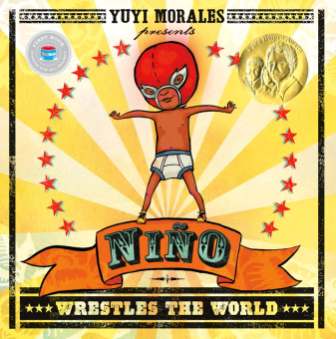 “Niño Wrestles the World”
“Niño Wrestles the World”
Written and illustrated by Yuyi Morales, celebrates play and the power of the imagination through the unforgettable, underpants-wearing Niño. Pulling from Mexican folklore, Morales pits a series of silly, slightly spooky opponents against Niño. But no foe can stand up to the cunning competitor. He takes down his challengers with a Slish! Boop! Crunch! – playfully defeating each one. Winner of the Pura Belpre Illustrator Award for affirming Latino culture and experience, and the SCBWI Golden Kite Picture Book Illustration Honor.
 “And Tango Makes Three”
“And Tango Makes Three”
Written by Justin Richardson and Peter Parnell and illustrated by Henry Cole, follows two male penguins in the Central Park Zoo through their fruitless efforts to hatch a rock. One day a zookeeper gives the dedicated fathers-to-be an extra egg that needs to be cared for. From this egg comes Tango, the very first penguin in the zoo to have two daddies. Based on a true story, winner of the ASPCA Henry Bergh Award.
 “Tiger in My Soup“
“Tiger in My Soup“
Written by Kashmira Sheth and illustrated by Jeffrey Ebbeler, features a young Indian-American boy determined to make his older sister read aloud his favorite story about a ferocious tiger. When she repeatedly puts him off, his imagination takes over and the tiger springs from his alphabet soup. An epic battle between boy and tiger commences, all behind the back of the distracted sister. While the hero eventually gets both his story and his reheated soup, he keeps a wary eye out for the tiger’s return.
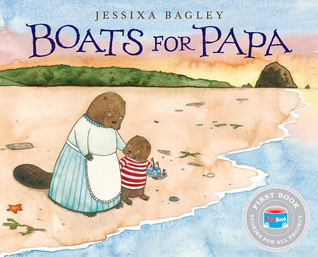 “Boats for Papa”
“Boats for Papa”
Written and illustrated by new author/illustrator Jessixa Bagley, explores the healing love between a child and parent. Buckley the beaver loves to carve toy boats out of driftwood from the beach nearby. With Mama’s permission, he sends a boat out to sea for his father, whom he misses very much. Buckley believes that if the boat does not come back, it must have reached his Papa. He sends boat after boat to Papa, each one more beautiful that the last. Then one day
Buckley finds all of his boats carefully collected and kept by his Mama. Buckley sends one last boat – this time with a new message.
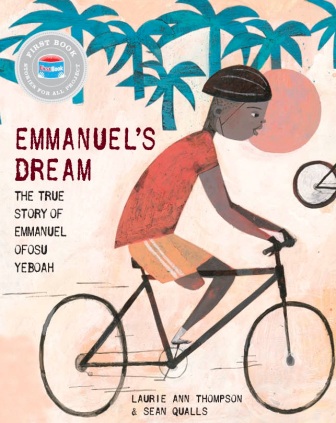 “Emmanuel’s Dream: The True Story of Emmanuel Ofosu Yeboah”
“Emmanuel’s Dream: The True Story of Emmanuel Ofosu Yeboah”
Written by first-time picture book author Laurie Ann Thompson and illustrated by Sean Qualls, is an inspiring true story about triumph over adversity. Born in Ghana with one disabled leg, Emmanuel was dismissed by most people, but taught by his mother to reach for his dreams. He hopped to school more than two miles each way, learned to play soccer, left home at age 13 to provide for his family, and eventually became a cyclist. In 2011, he rode an astonishing four hundred miles across Ghana spreading his powerful message: disability is not inability.
 “Knock Knock: My Dad’s Dream for Me”
“Knock Knock: My Dad’s Dream for Me”
Written by Daniel Beaty and illustrated by Bryan Collier, is a heartbreaking and hopeful story about love and loss. Every morning, a boy and his father play a game. While the boy pretends to sleep, his father knocks on the door and approaches the bed to say, “I love you.” One day, there is no knock. This powerful and inspiring book shows the love that an absent parent can leave behind and the strength that children find in themselves as they grow up and follow their dreams. Winner of the Coretta Scott King Illustrator Award.
The post Six Diverse Stories: Our 2015 Stories for All Project Selections appeared first on First Book Blog.


By: Samantha McGinnis,
on 4/8/2014
Blog:
First Book
(
Login to Add to MyJacketFlap)
JacketFlap tags:
Literacy,
Diversity,
Book Lists,
Books & Reading,
Marketplace,
Authors & Illustrators,
pat mora,
Guest Blog Posts,
El día de los libros,
El día de los niños,
Grandma's Chocolate,
Stories for All,
Celebrity Guest Bloggers,
Crazy Horse's Vision,
Meet Danitra Brown,
Tomás and the Library Lady,
Add a tag
Today’s guest blog post is by Pat Mora, award-winning author and founder of El día le los niños, El día de los libros/Children’s Day, Book Day.
All the books Pat recommends are available at deeply discounted prices on the First Book Marketplace to educators and programs serving children in need.
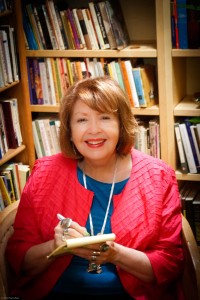 A lifetime of reading teaches us the pleasure and power of books, and that literature at all levels and from all cultures can not only teach us but humanize us.
A lifetime of reading teaches us the pleasure and power of books, and that literature at all levels and from all cultures can not only teach us but humanize us.
Through the writings of others we can share the experiences of a Midwest family on a farm years ago, the fear of a Jewish family during the Holocaust or the internment terror of Japanese families here during World War II. As readers, we can share in the triumph of a black family or an Egyptian family that writes a play about its history or traditions. By reading writers from the diverse cultures that are part of our United States, children learn new songs, celebrations, folk tales and stories with a cultural context.
This is what El día de los niños, El día de los libros/Children’s Day, Book Day is all about – implementing creative literacy strategies using diverse books and planning Día book fiestas for all children, from all cultures, in all languages. High-quality children’s books that reflect our rich plurality are able to reveal the many ways we are all alike as well as the ways we are all different.
Another major element in Día is honoring. Do we connect our literacy goals and efforts with really honoring each child and honoring home languages and cultures? Once honoring culture becomes a priority, creative and dedicated staff and families can propose and share ideas. Teachers and parents can create a sense of “bookjoy” with stories, games, literacy crafts and read-alouds. Coaching parents who did not have diverse literacy experiences growing up is of particular importance; whether a family is Spanish- speaking, English-speaking, Chinese-speaking, etc., we need to invest in respectfully and innovatively coaching multilingual families to join us in sharing a love of books.
Today, twenty-five percent of our children live in poverty – including one-third of black and Hispanic children. By 2018, children of color will be the majority in the U.S. What can we do to serve them and their families well? Celebrating Día and creatively championing the importance of literacy for children from all backgrounds is one way to start. Here’s to becoming a reading nation!
Here are 4 titles that can help you spread “bookjoy” and celebrate El día de los niños, El Día de los libros/Children’s Day, Book Day with children in your community! Sign up with First Book to access these and other great titles on the First Book Marketplace.
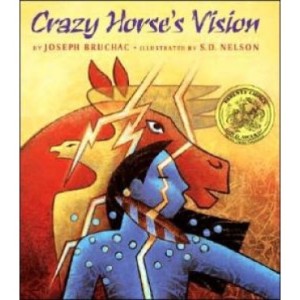
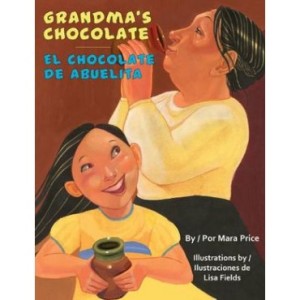
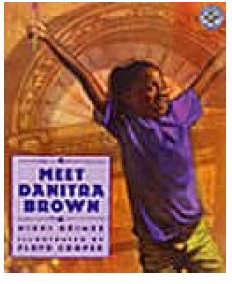
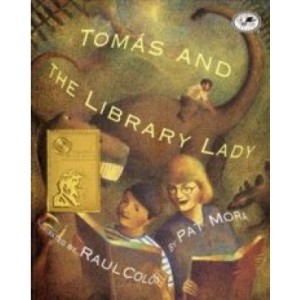
You can learn more about Pat Mora and El día de los niños, El Día de los libros/Children’s Day, Book Day on Pat’s website.
The post Four Books to Celebrate El día de los niños appeared first on First Book Blog.


By: Gina Rullo,
on 10/1/2013
Blog:
First Book
(
Login to Add to MyJacketFlap)
JacketFlap tags:
Interviews,
books,
reading,
Books & Reading,
Authors & Illustrators,
First Book,
Q&A,
First Book Marketplace,
Todd Parr,
First Book Partners,
First Book Supporters,
stories for all,
Add a tag
Author, illustrator, and macaroni and cheese aficionado Todd Parr, uses humor and bright illustrations to celebrate the differences that make us all unique. Most of Todd’s books are now available on the First Book Marketplace.
First Book recently interviewed Todd about his inspiration for writing so many books that make a difference in children’s lives.

Todd Parr (Photo Credit: Jeff Fielding)
Todd Parr: Yes, in second grade I was placed in a slow reader class because I could not keep up with the rest of the class. I also couldn’t read in front of the class. It made me feel very different because I was made fun of. This was a big part in my writing It’s Okay To Be Different.
The Family Book was somewhat inspired by losing my mom at a young age and feeling like my family was different.
Q: Have there been any children you’ve met along the way that have inspired you to tackle such issues?
Todd Parr: All the time. I never dreamed these two books would lead my awareness of the need to help kids and families feel good about themselves no matter what they were dealing with.
Q: Why is it important for children to be reading about diversity issues at such a young age?
Todd Parr: Because I believe it is important for kids to see that everyone is different. And that is what makes everyone special and unique.
Q: In your experience, how have children reacted to reading these books? Do they understand the nature of what they are reading?
Todd Parr: Yes, I think it’s my art style that helps with the delivery of the message (kids think they can draw just like me – and they can). Also, humor and unpredictability helps a lot.
 Q: What is your goal when writing children’s books that address these topics?
Q: What is your goal when writing children’s books that address these topics?
Todd Parr: To present things that may be very complicated to understand in a simple fun way.
Q: What inspired you to become a children’s author?
Todd Parr: It all came about through my art. Megan Tingley (Little, Brown) approached me at the licensing show in NYC and asked if I had ever thought about writing children’s books because I was basically already telling stories through my artwork.
Q: It’s pretty clear that you love macaroni and cheese. What’s your favorite kind?
Todd Parr: Can I say I am so easy to please that I will eat any kind of macaroni and cheese, even if it has worms on it. No, that’s not right…
Todd Parr’s books are available on the First Book Marketplace, a website exclusively for educators and program leaders that works with kids in need.
The post Stories For All: Todd Parr – It’s Okay to be Different appeared first on First Book Blog.


By: Tracy Bartley,
on 7/1/2013
Blog:
First Book
(
Login to Add to MyJacketFlap)
JacketFlap tags:
Clinton Global Initiative,
Stories For All Project,
Jane Robinson,
diversity publishing,
stories for all,
children's books,
kidlit,
books,
Literacy,
diversity,
Books & Reading,
Education,
CGI,
Teachers,
children’s literature,
Add a tag
“The issue is cultural relevance,” said Jane Robinson, First Book Chief Financial Officer, addressing a room of Clinton Global Initiative attendees, all experts in the field of education. “Children need to see themselves in what they read. Because the price of books is high, book content most often reflects the lives of people of means.”
First Book’s recent attendance at the Clinton Global Initiative and corresponding commitment to remedy the lack of diversity in children’s literature has garnered a good bit of media attention. A wide range of news sources, including Native News Network, GalleyCat, Examiner.com, BooksWorld, The Guardian, and an article in Publisher’s Weekly featured our commitment and our Stories For All project.

To expand diversity in children’s literature we are pioneering a market-driven solution. The First Book Marketplace is an online store available only to educators and program leaders serving kids in need. To stock the Marketplace, First Book purchases new books from publishers on a non-refundable basis. Because of this, publishers gain access to a new market of consumers without having to stock shelves, market or distribute their books. Educators, program leaders, and — most importantly — kids in need, gain access to the highest quality books and stories that accurately reflect their reality.
The post First Book at the Clinton Global Initiative: Expanding Diversity in Children’s Literature appeared first on First Book Blog.


 That is wonderful to hear. I was just struck that they had more suggestions than any group I’d worked with, they could hardly be contained. They had so much they wanted to say and I think it’s very fresh in their minds what welcoming looks like and maybe what did or what didn’t happen for them. So the list that they wrote: welcome to my class, say hi, wave, smile, hello, say this is my classroom, these are my friends, do you want to become friends? these are my parents, this is my family, show them around, this is my chair, this is my house, this is your school, this is my teacher, can you read with me? how’s it going? I live here, where do you live? do you need help? welcome to my school.
That is wonderful to hear. I was just struck that they had more suggestions than any group I’d worked with, they could hardly be contained. They had so much they wanted to say and I think it’s very fresh in their minds what welcoming looks like and maybe what did or what didn’t happen for them. So the list that they wrote: welcome to my class, say hi, wave, smile, hello, say this is my classroom, these are my friends, do you want to become friends? these are my parents, this is my family, show them around, this is my chair, this is my house, this is your school, this is my teacher, can you read with me? how’s it going? I live here, where do you live? do you need help? welcome to my school.




 Q. Do you see your teenage self in any of your novels? If so, which one(s) and in what ways?
Q. Do you see your teenage self in any of your novels? If so, which one(s) and in what ways?





 A lifetime of reading teaches us the pleasure and power of books, and that literature at all levels and from all cultures can not only teach us but humanize us.
A lifetime of reading teaches us the pleasure and power of books, and that literature at all levels and from all cultures can not only teach us but humanize us.





